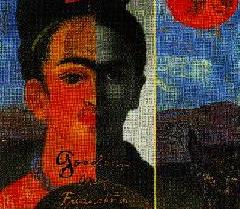SEARCH CurtainUp
REVIEWS
FEATURES
NEWS (Etcetera)
ADDRESS BOOKS
Broadway
Off-Broadway
BOOKS and CDs
OTHER PLACES
Berkshires
London
Los Angeles
Philadelphia
Elsewhere
QUOTES
On TKTS
LETTERS TO EDITOR
FILM
LINKS
MISCELLANEOUS
Free Updates
Masthead
NYC Weather
Goodbye My Friduchita
by Les Gutman

|
This play, which had a lengthy, successful run in Miami a couple of years ago, is the biography of the fascinating Mexican painter, Frida Kahlo. She was a person with respect to whom the intriguing symbolism of her art was in constant competition with the extreme reality of her existence. Most everything, it seems, was a compromise between pain and joy. She spent much of her life -- she died forty-five years ago at age 47 -- suffering from the consequences of a terrible school bus accident, but what the public saw was a vibrant, exciting whirlwind: she socialized with the world's notables, most always as the center of attention. She fell in love with and married the great muralist Diego Rivera early, and her affection for him never diminished. She had a storybook life with him, but he was hopelessly unfaithful. Her anguish was uncontrollable, and the palliative of her own sexual adventures was fleeting.
All of this begs to be dramatized, but almost defies the effort. Giving expression on stage to someone best known for conveying feelings non-verbally is one of the greatest playwriting and directorial challenges. (We've witnessed this most recently and at its worst in a spate of plays about Nijinsky, linked below.) Here, the first test is to find a means to convert the power of Kahlo's painting into some sort of stage energy. The second is to discover a means by which the audience can share in the experience and excitement of her passions.
With some savvy ideas from director Michael Garcés, the play does a remarkable job of integrating Kahlo's work as well as the concepts and philosophy that support it. An almost constant stream of projections (all exceptionally good, by Elaine J. McCarthy) fill two enormous easels, one to each side of the stage, as well as a backdrop. (The remainder of the set is quite simple, and yet resplendently evocative of Mexico.) As Kahlo's life unfolds onstage, her contemporaneous artistic impression of it proceeds on the screens. It's a wonderful lesson in appreciating her art in the context of her life. Most of her paintings are autobiographical: she paints an orchid as a discarded uterus, testament to her many miscarriages and abortions.""I never painted dreams," she says, "I paint my own reality." She lectures her students on the use of color as she sends them to the field to paint what they see. A "color dance" at the end of the first act punctuates it with a healthy dose of spirited movement.
The play is less successful in manifesting the spectacle of Kahlo's life. Its central device is to employ two Fridas. As the play opens, Kahlo's casket sits at center stage. Her spirit (Priscilla Lopez) enters to serve, essentially, as our tour guide through her life. At times she portrays Frida; most of the time she narrates. Young Frida (Anilú Pardo) both interacts with her and represents her words in action. The remaining three performers fluidly fill in the remaining minor functions.
Lopez, a particularly gifted performer best known as the original Morales in A Chorus Line but who has a long and impressive list of other stage and film credits (including a Tony for playing Harpo Marx in A Day in Hollywood/A Night in the Ukraine) wonderfully invests Frida with a mix of spunk and fear, pride and hurt. She captures Kahlo's legendary uninhibitedness perfectly. Pardo, herself a well-known Mexican performer, mirrors Frida's emotions splendidly, substituting a degree of innocence (but not much) for the older, wiser Frida's jadedness.
What's lost is the immediacy of Kahlo's relationship with Rivera (he is not represented onstage), and the concomitant sense of the international "fast lane" in which they traveled. Frida was not impressed. She relates meeting everyone from Trotsky (she applied her color regime to him: red on the outside, but yellow within) to Henry Ford (hearing he is anti-Semitic, she asks him if he is a Jew). But something of her exuberance, of her outrageousness, of what in Spanish is called alegría that masks her pain, is missing. We see much more of what is underneath than what is exposed, but it is the latter -- her public persona -- which informs our understanding of her. Sendler has actors announce the year as the play progresses, and the corresponding catalog of crises in Kahlo's life: operations, miscarriages, suicide attempts and so on. While much can be said for not over-romanticizing, Sendler seems to have erred on the side of caution.
LINKS MENTIONED ABOVE
CurtainUp's reviews of three attempts at dramatizing the life of Nijinsky: The Death of a Faun, Nijinsky Speaks and Nijinsky's Last Dance
| GOODBYE MY FRIDUCHITA
by Delores C. Sendler Directed by Michael John Garcés with Priscilla López, Anilú Pardo, David Anzuelo, Claudia J. Arenas and Bill Torres Set Design: Troy Hourie Lighting Design: Robert Williams Costume Design: Mimi O'Donnell Projection Design: Elaine J. McCarthy Original Music: Gregory D. Sendler Choreography: Vera Huff Sound Design: William Padilla The Directors Company, 311 West 43rd Street (8/9 AV) (212) 712-7458 opened July 12, 1999 closes August 7 Seen July 12, 1999 and reviewed by Les Gutman July 13, 1999 |


